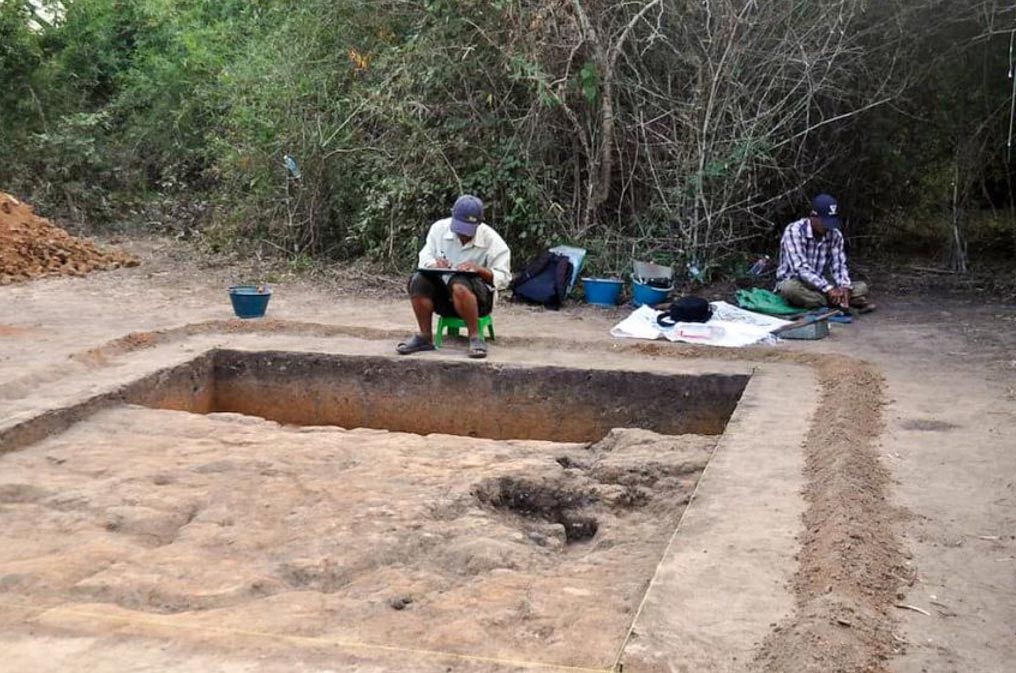New Discoveries at Ancient Cambodian Capital Dispel Old Beliefs
After the Siamese (Thai) people sacked Angkor in 1431 AD, the usual view is that Cambodia descended into a centuries-long dark age of isolation at the new capital its people established, called Longvek. But archaeologists working there say it’s no accident Longvek was built on the Mekong River near the sea, which allowed trade in East Asia.
Researchers doing the first excavations have found porcelain in the ruins of Longvek from China, Japan, Vietnam, and Thailand, says a story at The Phnom Penh Post. They also found a bronze workshop and substantial earthen walls.
“Archeologists, historians, tourists and the general public—everyone tends to focus on Angkor’s golden age, and when you go to Angkor you can see the reason why,” Martin Polkinghorne, a research fellow at Flinders University in Australia who is part of a team excavating Longvek that includes scholars from Cambodia’s Ministry of Culture, Flinders and Japan’s Nara Institute, told the Post. “But of course Cambodian history continued and was intimately tied to international trade.”
Dr. Polkinghorne said Longvek and Cambodia’s economy was based on the export of forest products, including hardwoods and animal skins. The team found Ming Dynasty porcelain from the 16th century in the palace at Longvek.
Dr. Polkinghorne said he believes his team is the first to excavate Longvek. He also warned that urbanization from Phnom Penh threatens the site. The modern capital is about 50 kilometers (31 miles) from Longvek, which is not protected by a conservation as Angkor is. Angkor is in Siem Reap province, while the ruins of Longvek are in Kampong Chhnang province.

Some pottery found at the Krang Kor site in Cambodia. (Nara National Research Institute for Cultural Properties)
The website Cambodia Picture Tour says Longvek was the capital from 1529 to 1593. Khmer King Chan Reachea built it beginning in 1527 in a rectangle 2 km by 3 km (1.2 by 1.8 miles). King Ang Chan built the palace in 1553.
- New discoveries redefine history of Angkor Wat
- Built by Kings, the Ancient Bayon Temple of Cambodia Mixes Spirituality, History and Symbolism
- High-Tech Equipment Leads to Discovery of Lost City in Cambodian Jungle
- New research unravels rise and fall of ancient Cambodian city Mahendraparvata
The blog Cambodiaub explains that Longvek means “crossroads” or “intersection,” and foreigners knew Cambodia by that name for a time. The blog also describes the conflict that led to the establishment of Longvek - a civil war between Sdech Kan and Ponhea Chan. Ponhea Chan was victorious and became the king of Cambodia. Spanish and Portuguese explorers, including Blas Ruiz de Hernán González, first visited the kingdom in this time, the 16th century, as well.
King Satha, a later king in Longvek, welcomed foreigners and became friends with Portuguese explorer Diego Beloso. Soon after their meetings, in 1593, King Naresuan of Siam conquered Longvek.

Compared to the high art and architecture of the old capital of Angkor Wat, it may seem like the new capital of Longvek presided over a dark age. But new research at Longvek shows the Cambodians traded around East Asia and had other marks of a civilization. This relief from Angkor shows a battle scene with an elephant. (Manfred Werner/CC BY SA 3.0)
“This conquest marked a downturn in the kingdom's fortunes,” the blog states. “In the historical period that followed, Cambodia became a pawn in a power struggle between its two increasingly powerful neighbors, Siam and Vietnam. In 1618, the capital of Cambodia was once again relocated and was moved to Oudong.”
Oudong is not far from Longvek.
A site of the Japanese government, (which has also shown an interest in Longvek) says:
“Much of the history from the abandonment of the Angkor capital in the 15th century up to the time when France made Cambodia a protectorate remains shrouded in mystery, as there is little historical material from the period and few archaeological excavations or other studies have been carried out to date.”
That dearth of information is being rectified by the recent studies in Longvek. The team of archaeologists, which began excavations in November and continued into December, will do a four-year study of the ancient capital. They intend to return later to do more excavations in 2016.
Featured image: Excavations are underway at Longvek, a site that was capital of Cambodia after Angkor fell in the 15th century. (Flinders University)
By: Mark Miller



















